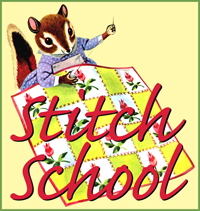
Let’s start at the beginning. How did you get started collecting and selling feedsacks?
The feedsack business resulted from a number of coincidences. First, my husband and I have been into antiques for years, both separately and together. When we got together, he had a used bookstore and I operated a stand selling general antiques at a local antique market.
 We started selling on eBay in late 1997, as the internet began to make big changes in the marketplace. One major change was in my husband’s field, used books, and it became less practical to have a physical store instead of an online presence. So we decided he’d give up the store and sell online.
We started selling on eBay in late 1997, as the internet began to make big changes in the marketplace. One major change was in my husband’s field, used books, and it became less practical to have a physical store instead of an online presence. So we decided he’d give up the store and sell online.He found free webspace and started a list of books for sale there, also listing with a service that included a national selection of booksellers. Since he had created the website for his books, he looked around to see what sort of website would benefit my business, and what items would lend themselves to sale online. While selling on eBay, we found that feedsacks (we had always called them feed bags) had begun to sell for more than the dollar or two that they usually brought around here. Since they were easy to scan (we didn’t yet have a digital camera), we selected feedsacks for our beginning web site.
You live in a great area of the country for finding feedsacks with lots of farms and Amish communities. Do you find most of your feedsacks locally or do you travel to find them?
We find most of our feedsacks at farm sales and auctions in our local area, though we have bought them from friends as far away as Nebraska and even California. We also scour local antique markets and co-ops for feedsacks. When the Feedsack Club was in operation, we were members and bought lots of them at the annual conventions. And as our website grew, we were sometimes even able to buy some on eBay to resell on our site.
As far as traveling, we don’t travel a lot anyway, but when we do, of course we stop at antiques shops and look for feedsacks and other textiles, but nowhere are they as plentiful as in our local area.
I don’t think we need to tell the whole history of feedsacks since others have done that elsewhere. But when were feedsacks produced—what dates are we talking about?
 My website presents a brief history of feedsacks: What is a feedsack?Handmade grain bags of homespun linen were used in the early 1800’s to carry grain to and from the mill, but in the later 1800s these were replaced by commercially made cotton bags. These early cotton bags were still taken back to the mill and reused many times, and were often imprinted with the owner’s name. It wasn’t until the 1920s or 30s that someone had the idea to use printed fabric in bags so that they might be reused for other purposes. These printed bags are what we generally mean when we talk about feedsacks today, and were in general use from the 1930s through the 1950s. According to one source, more than 50 million were produced in just one year of the 1940s.
My website presents a brief history of feedsacks: What is a feedsack?Handmade grain bags of homespun linen were used in the early 1800’s to carry grain to and from the mill, but in the later 1800s these were replaced by commercially made cotton bags. These early cotton bags were still taken back to the mill and reused many times, and were often imprinted with the owner’s name. It wasn’t until the 1920s or 30s that someone had the idea to use printed fabric in bags so that they might be reused for other purposes. These printed bags are what we generally mean when we talk about feedsacks today, and were in general use from the 1930s through the 1950s. According to one source, more than 50 million were produced in just one year of the 1940s.I’ve heard there were more than 15,000 different patterns printed on feedsacks during their production. Is that true?
There is a Florida lady, a member of the former feedsack club, who has been saving swatches in a number of binders, organized by pattern, including different colorways of the same pattern. It is my understanding that she’s now isolated 20,000 different feedsacks, and is still adding more.
Wow, wouldn’t you love to get a peek at those binders!
Personally, I love the large-scale floral designs and anything with that gorgeous lime green color they used. What are your favorite designs?
My favorite designs are the ones with dots or bubbles, and some of the art deco prints. I, too, like that bright lime green, but I like how all the colors seem to go well together.
There are two kinds of fabric used for feedsacks, right? Is one considered to be better or more valuable than the other? Can the type of fabric used help in dating a feedsack?
 There are actually more than two different weaves used for feedsacks. Limiting the discussion to just the printed sacks, there are some that are much coarser and more loosely woven, that quilters do not want. Then there’s the standard feedsack texture that is the most common, and a finer weave, probably usually from flour sacks or other finely milled products. These are often found in the pillowcase, or border type prints.
There are actually more than two different weaves used for feedsacks. Limiting the discussion to just the printed sacks, there are some that are much coarser and more loosely woven, that quilters do not want. Then there’s the standard feedsack texture that is the most common, and a finer weave, probably usually from flour sacks or other finely milled products. These are often found in the pillowcase, or border type prints.Also, among the standard weave sacks, there are some few that have a slight texture in rows along the sack. But there are a few more exceptions. I’ve seen a checked feedsack fabric with metallic threads woven in, and I’m pretty sure some were made with rayon or a synthetic fiber of some sort, not just cotton.
Is it true that the same fabrics used to make feedsacks were also sold as yardage? I’ve seen fabric that I’m sure was feedsack yet it was much too large to have been one.
I’ve owned a few pieces of feedsack yardage—the giveaway is that it’s usually 37 or 38 inches wide, from a time when almost all other printed cottons were only 36 inches. But it’s also true that the same patterns used on feedsacks were printed on regular cotton fabrics; I’ve owned examples of that, too.
I’ve mentioned looking for stitching holes as a way to identify feedsacks. Is there anything else to look for?
The stitching holes are the easiest, most obvious way to tell—but after you’ve seen enough feedsacks, you basically know them just by their texture.
Is there any way to tell how old a feedsack is? I read recently that sizes were standardized after a certain date, so anything oddly-sized that doesn’t fall into those standards would be earlier. True?
The standardization helps only if you have a feedsack with a label—earlier sacks often held 98 lbs of feed, while later ones were standardized at 100 lbs. The way I determine the age of a sack—if I need to—is by pattern. Some patterns are obviously 30s, some 40s, some 50s. At least once you get to know fabrics from those eras. Some patterns are also timeless, like gingham checks, polka dots, etc., so it’s not easy to determine the age, though I don’t know why you’d have to.
People sometimes email me with their stories about feedsacks. One woman told me that her mother made all of her and her sisters dresses from feedsacks and then used all the little leftover scraps for quilts to cover their beds. Have you heard any good feedsack stories?
 I don’t come from a farm family, but my grandmother did keep a few chickens and was an accomplished seamstress. So yes, she did make me dresses from feedsacks. And because I didn’t live in a particularly rural area, I wasn’t aware of the stigma that some girls sometimes felt when wearing feedsack dresses rather than store-bought.
I don’t come from a farm family, but my grandmother did keep a few chickens and was an accomplished seamstress. So yes, she did make me dresses from feedsacks. And because I didn’t live in a particularly rural area, I wasn’t aware of the stigma that some girls sometimes felt when wearing feedsack dresses rather than store-bought.One story told to me by my former postmaster concerned her embarrassment when playing on the playground with other kids. Seems that when she came down the slide, her dress flew up, and everyone laughed to see the gold medal on her underdrawers.
Where should people look for feedsacks?
One of the most popular places to find feedsacks today is on eBay. There they bring prices from a few dollars to near $100, which we’ll talk about next. If you live in farm country, you can sometimes find them at estate sales, farm auctions, and yard sales, but they’re turning up less often than they did a few years ago. We find most of ours this way, along with scouring the local antique and flea markets.
In this age of the internet, there are a number of online sources for feedsacks. My website—Sharon’s Antiques: Vintage Fabrics is one of the larger ones offering feedsacks, and has been operating for more than eleven years. In that time we’ve sold many thousands! A quick search on Google will turn up many other sites offering feedsacks as well.
Let’s talk about pricing. I feel lucky to have paid between $10 and $15 for most of the feedsacks I’ve collected. Yet I’ve seen them sell for close to $100 on Ebay. What can a new collector expect to pay for a feedsack?
Prices of feedsacks depend primarily on their desirability. On eBay, the juvenile and novelty sacks seem to bring the highest prices, because of both the wide demand and the short supply of these sacks. Because the Japanese are great fans of feedsacks, the market prices responded to a great demand from Japanese quilters and crafters by rising sharply about 9 years ago, and patterns popular with the Japanese still bring much higher prices, though the demand has now dwindled somewhat.
Of course, if you’re lucky enough, you can sometimes find feedsacks at very low prices. Most of us will then buy all we can, and hope to trade up with ones that we don’t need for ourselves.
And some patterns are rarer or more popular than others, right? Is that why some sell for eye-popping prices?
As I mentioned above, the juvenile patterns are both rarer and more popular. I’ve seen sacks with nursery rhyme themes sell for well over $100. Some colors are harder to find than others. Yellow is especially popular and sacks with a bright yellow background tend to sell for more than most other colors.

Can you recommend any sources of information about feedsacks?
There are several feedsack books, Susan Miller’s Vintage Feed Sacks: Fabric From the Farm is available and has a lot of information and pictures. Though now out of print, Identification and Value Guide to Textile Bags by Anna Lue Cook is often available used and also has some useful information, though not as many pictures of popular feedsack patterns.
Google is still one of the best ways to find feedsack information, though there’s also plenty of misinformation on the web (and in books for that matter). Joan Kiplinger’s Vintage Fabrics column on fabrics.net has featured several articles on feedsacks and feedsack fabric - Feedbags: From Rags to Riches and Osnaburg the Great: Feedsacks on Our Backs are two of the best. And you’ll find plenty of places to look at pictures of feedsack fabric.
One last question. This relates to a comment Melody made on my post about copying of feedsacks for current reproductions. She said that the colors of the originals seemed much more saturated than the copies and wondered why. This is something I've noticed, too.
As to printing colors and quality, I assume it’s all in the dye chemistry. Colors through the years have changed, we can all compare antique fabrics to today’s repros and see the sometimes subtle and sometimes glaring differences. Feedsacks are remarkably bright and colorfast, with minor exceptions, so they must have used decent quality dyes. Perhaps they used dyes that would be considered “unsafe” now, but the new colors are probably just less expensive.
A big thanks to Sharon for taking time from her busy schedule to answer my questions. Be sure to check out the Feedsack Friday posts on her blog. One way to become familiar with feedsacks is to look at patterns and colors and she shows some gorgeous examples!
















4 comments:
Interesting. Love to learn new things like this.
Thank you for sharing this! Very interesting and informative!
What an inforamative interview! I'd love to stow away in her car when she goes antiqueing!!!!
Thanks so much for sharing.
Awesome interview, Janet! I learned lots of things :-)
Post a Comment